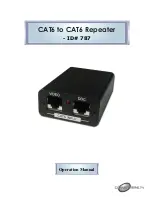
18
LTR-T Installation Guide
10BASE-T Wiring Conventions
There are two standard RJ45 pin assignments used in connecting 10BASE-T equipment
using unshielded twisted-pair (UTP) cable. They are referred to as an MDI (Medium-
Dependent Interface) and MDI-X. The MDI designation refers to devices which transmit
on RJ45 pins 1 and 2 and receive on pins 3 and 6. MDI-X refers to devices which
transmit on pins 3 and 6 and receive on pins 1 and 2. In general, end nodes (Ethernet
cards, workstations, transceivers, etc.) are MDI, while virtually all 10BASE-T hubs and
concentrators are MDI-X. See Appendix B for the pinouts for the two cases.
The motivation behind using two different interface types is to simplify the wiring
between devices. For proper operation, the transmit signal pair at one interface must
connect to the receive signal pair at the second interface, and vice versa. Since MDI
devices are usually connected to MDI-X devices, a straight-through cable works in most
cases. A swapped cable exchanges the transmit signal pair with the receive signal pair in
the absence of an MDI-X device at one end of the cable. MDI-X can be thought of as
swapping the signals internally.
To connect two MDI devices (i.e., two workstations back to back), or two MDI-X devices
(i.e., two hubs) a swapped cable is required. Because connecting two hubs is a common
occurrence, however, the LTR-T provides one or two (LTR-16T ) ports that can be
switched between MDI and MDI-X, as discussed in the next section.
Содержание LTR8T
Страница 1: ...LTR T Installation Guide...
Страница 4: ......
Страница 28: ......
Страница 30: ......
Страница 34: ...Appendix B 28 LTR T Installation Guide...













































